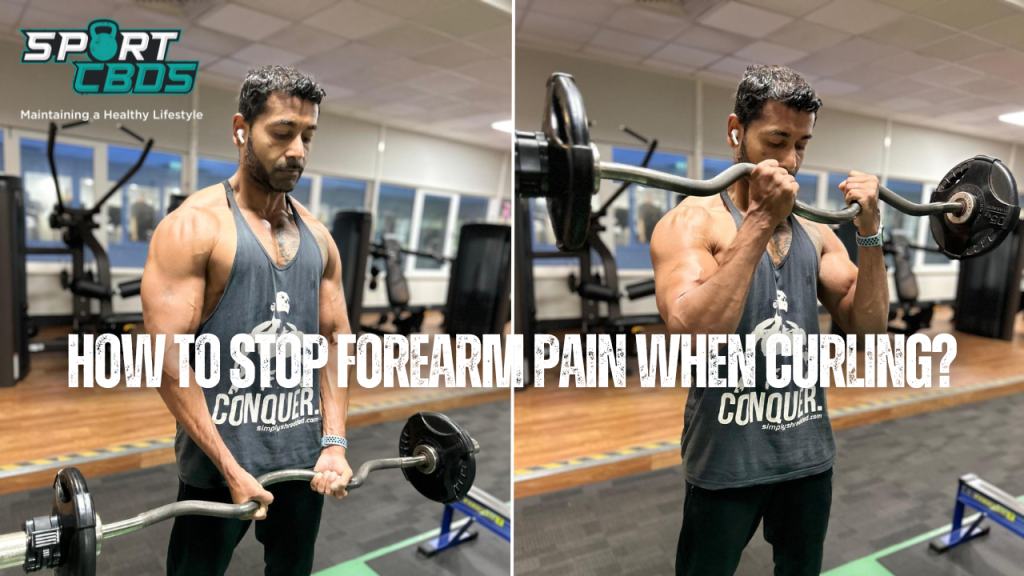
Say Goodbye to Forearm Pain: How to Stop Forearm Pain When Curling
Experiencing forearm pain when curling is a common issue faced by many fitness enthusiasts and weightlifters.
This pain, often a result of improper technique or overuse, can significantly hinder your workout routine and progress.
Addressing this issue is crucial not only for maintaining your performance but also for preventing further injuries that could lead to long-term complications.
In this article, we will delve into the causes of forearm pain during curling and provide practical strategies to prevent and alleviate this discomfort.
How to Stop Forearm Pain When Curling?
To stop forearm pain when curling, it’s crucial to implement several strategies. Firstly, ensure you’re using the correct form and technique during your curls. Your wrists should be in a neutral position, and the lifting force should come from your biceps, not your forearms. Secondly, always warm up before your workout to prepare your muscles and cool down afterward to aid recovery. If you’re experiencing pain, consider reducing your training volume or taking extra rest days. Using an EZ bar can also help reduce strain on your forearms. If the pain persists, the RICE (Rest, Ice, Compression, Elevation) method can help alleviate pain and inflammation. Regular forearm and wrist stretches can also be beneficial. If the pain persists or worsens, it’s important to seek medical attention.
Understanding the Forearm Pain
Forearm pain during curling can be a frustrating hurdle in your fitness journey. To effectively address this issue, it’s essential to understand why it occurs. The forearm comprises various muscles and tendons that work in unison to facilitate the curling motion. When you curl, especially during a bicep curl, your forearm muscles contract and your tendons bear the load of the weight.
However, several factors can lead to pain in these areas. One of the most common causes is incorrect lifting technique. When you curl with improper form, it puts undue stress on your forearm muscles and tendons, leading to pain and discomfort. For instance, flexing your wrists too much or using your forearms instead of your biceps to lift the weight can strain these muscles.
Overuse is another common culprit. Consistently performing high-volume training without adequate rest can overwork your forearm muscles, leading to fatigue, strain, and, consequently, pain.
Lastly, lifting weights that are too heavy for your current strength level can also cause forearm pain. When the weight is too heavy, you might inadvertently compensate by using improper form, putting excessive strain on your forearms.
By understanding these causes, you can take the necessary steps to prevent forearm pain and ensure a safe and effective workout.
Causes of Forearm Pain When Curling
Forearm pain during curling can be attributed to several factors, each contributing to the discomfort in its own way. Here are the most common causes:
- Incorrect Lifting Technique: This is one of the most prevalent causes of forearm pain. Improper form, such as flexing the wrists excessively or using the forearms instead of the biceps to lift the weight, can put undue stress on the forearm muscles and tendons. This strain can lead to pain and discomfort during and after the workout.
- Overuse of Forearm Muscles: Consistent high-volume training without adequate rest can lead to overuse of the forearm muscles. Over time, this can result in muscle fatigue, strain, and pain.
- Lifting Weights That Are Too Heavy: Attempting to lift weights beyond your current strength level can also cause forearm pain. When the weight is too heavy, you might inadvertently compensate by using improper form, which can put excessive strain on your forearms.
- Lack of Warm-Up Before Exercise: Warming up before a workout is crucial for preparing your muscles for the exercise. Skipping the warm-up can result in tight, unprepared muscles, increasing the risk of strain and injury.
Related: Why Do My Biceps Fatigue So Fast? Causes, Prevention, and More!
How to Prevent Forearm Pain When Curling
Preventing forearm pain when curling involves a combination of proper technique, adequate preparation, and sensible training habits. Here’s how to do it:
- Importance of Proper Form and Technique: Always ensure that you’re using the correct form when curling. Keep your wrists in a neutral position and use your biceps to lift the weight, not your forearms. If you’re unsure about your form, consider seeking advice from a fitness professional.
- The Role of Warm-Ups and Cool-Downs: Warm-ups prepare your muscles for the workout ahead, while cool-downs help your muscles recover afterward. Incorporate both into your routine to reduce the risk of muscle strain and injury.
- Choosing the Right Weight for Your Strength Level: Lifting weights that are too heavy can lead to improper form and increased strain on your forearms. Choose a weight that challenges you but still allows you to maintain proper form throughout your sets.
- Importance of Rest and Recovery: Give your muscles time to rest and recover between workouts. Overworking your muscles can lead to fatigue and strain, so ensure you’re taking adequate rest days and getting enough sleep.
By implementing these strategies, you can significantly reduce the risk of forearm pain when curling and ensure a safe and effective workout.
Effective Strategies to Alleviate Forearm Pain
If you’re experiencing forearm pain when curling, there are several strategies you can employ to alleviate the discomfort and promote healing:
- Rest, Ice, Compression, Elevation (RICE) Method: This is a tried-and-true method for treating minor injuries and reducing pain and inflammation. Rest allows your muscles to heal, ice reduces inflammation, compression helps limit swelling, and elevation can decrease blood flow to the area, further reducing swelling and discomfort.
- Forearm and Wrist Stretches: Regularly stretching your forearm and wrist can help alleviate tightness and reduce pain. There are several effective stretches you can try, such as the wrist flexor and extensor stretches. Remember to hold each stretch for at least 30 seconds for maximum benefit.
- Use of an EZ Bar for Curling: An EZ bar is designed to take some of the strain off your wrists and forearms when curling. Its unique shape allows for a more natural grip, which can help reduce forearm pain.
- Reducing Training Volume: If you’re experiencing forearm pain, it might be a sign that you’re overworking your muscles. Consider reducing your training volume or taking extra rest days to allow your muscles to recover.
When to Seek Medical Help
While minor forearm pain can often be managed with the strategies mentioned above, there are times when it’s important to seek medical help:
- Severe Pain: If your forearm pain is severe or gets worse over time, it’s crucial to seek medical attention. This could be a sign of a more serious injury, such as a fracture or severe strain.
- Pain That Doesn’t Improve With Rest: If your pain doesn’t improve after a few days of rest and self-care, it’s a good idea to see a doctor. Persistent pain could indicate a more serious underlying issue.
- Loss of Function: If you’re unable to move your wrist or hand normally, or if you’re experiencing weakness or numbness, seek medical help immediately.
Remember, professional guidance is invaluable in injury prevention and recovery. A healthcare professional can provide a proper diagnosis and recommend a treatment plan tailored to your specific needs.
Related: Is it Better to do Bicep Curls Against a Wall? Myth or Magic for Muscle Growth?
The Importance of Grip Strength
Improving grip strength can significantly help in mitigating forearm pain when curling. A stronger grip can enhance your control over the weights, reducing the strain on your forearm muscles and tendons.
A study published in the Journal of Physical Therapy Science found that grip strength training could effectively reduce forearm pain and improve function. To enhance your grip strength, consider using tools like the hand grip strengthener available on Amazon.
Additionally, incorporating CBD products from Sport CBDs into your recovery routine may help manage inflammation and pain, further supporting your efforts to stop forearm pain when curling.
FAQs
Here are some frequently asked questions related to forearm pain when curling:
How do I stop my forearms from hurting when doing bicep curls?
Ensure you’re using the correct form and technique. Keep your wrists in a neutral position and use your biceps to lift the weight, not your forearms. Also, consider using an EZ bar, which can reduce strain on your forearms.
How do I stop my forearm from hurting at the gym?
Warm up before your workout to prepare your muscles, and cool down afterward to aid recovery. If the pain persists, consider reducing your training volume or taking extra rest days.
What is the fastest way to relieve forearm pain?
The RICE (Rest, Ice, Compression, Elevation) method can help alleviate pain and inflammation. Regular forearm and wrist stretches can also be beneficial.
Why do my forearms hurt when I curl?
Forearm pain during curling can be due to several factors, including incorrect lifting technique, overuse of forearm muscles, lifting weights that are too heavy, or lack of warm-up before exercise.
Does forearm tendonitis go away?
Yes, with proper care and rest, forearm tendonitis can heal. However, it’s important to address the root cause to prevent recurrence. If the pain persists or worsens, seek medical attention.
Final Thoughts…
Forearm pain when curling is a common issue that can hinder your fitness progress. However, by understanding the causes and implementing effective strategies such as proper form and technique, adequate warm-ups and cool-downs, sensible weight selection, and sufficient rest and recovery, you can prevent and alleviate this discomfort.
Remember, it’s always important to listen to your body and seek professional help if the pain persists or worsens. Stay safe and keep curling!
Have you experienced forearm pain when curling? Have our tips been beneficial to your training? We’d love to hear your feedback, so please share your thoughts in the comments section below.
If you’re a sports enthusiast who utilizes CBD for optimal recovery after intense workouts, then you’ve found your tribe. Welcome to Sport CBDs, where we push our limits in training and prioritize recovery in the most effective way possible.
We regularly share workout routines on our YouTube channel and offer a range of health and fitness products designed to give you that competitive edge.
Why not explore the high-quality CBD products we proudly feature on our site? Visit the Sport CBDs Store by clicking here. In addition to CBD, we also offer an array of fitness clothing and yoga accessories to complement your active lifestyle.
Until next time, we wish you the best in your fitness journey. Remember, your progress is our passion. Stay strong and keep pushing!


